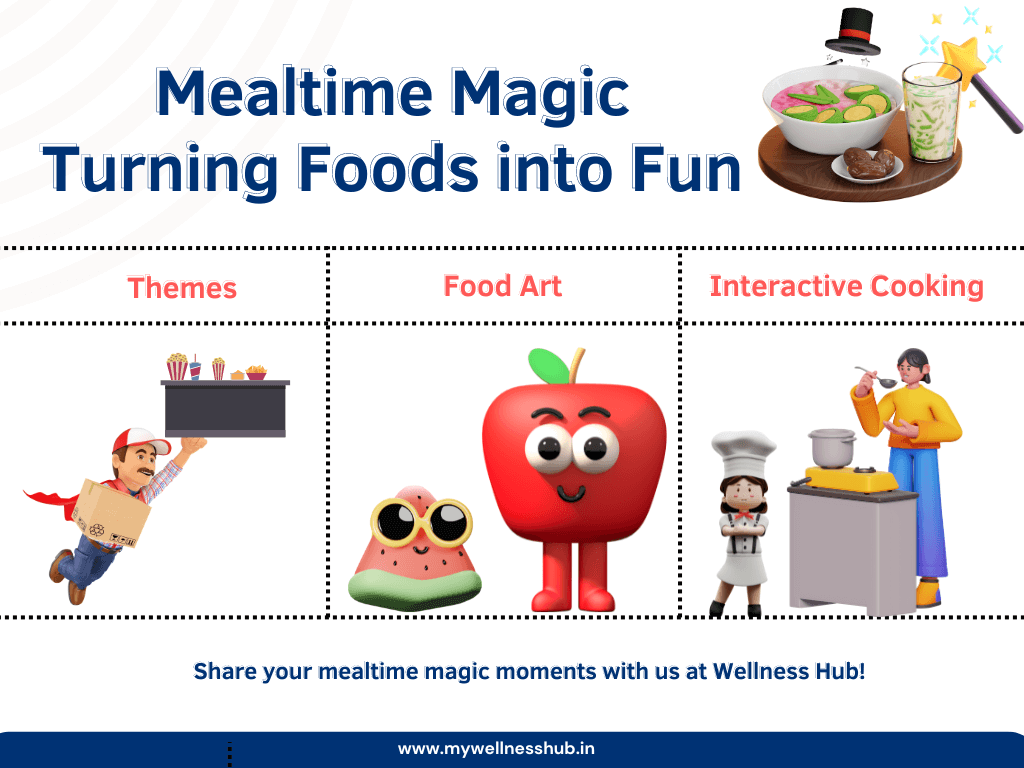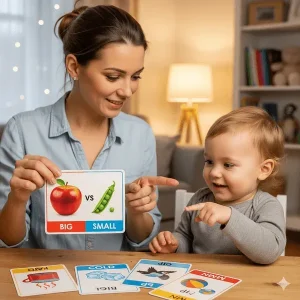8 Proven Ways to Get Your Child to Try New Foods
By Wellness Hub
Last Updated: September 14, 2024
Navigating the challenge of introducing new foods to child can often feel like a high-stakes negotiation at the dinner table. Many parents can relate to the strategic attempts just to get a child to try something green. This is a common dilemma worldwide, as parents search for the elusive recipe for success in feeding their kids. Fortunately, there’s no need for covert strategies. This guide provides simple, effective methods to transform mealtime into a delightful exploration, not a battle. We’ll help you cater to every type of young eater, from the picky to the adventurous, ensuring a healthier, happier dining experience for all.
Also read: Does Your Child Need Feeding Therapy – Signs, Strategies & Support
1. Start with Small Portions
Embarking on the adventure of introducing new foods to child can sometimes feel like navigating through a maze—exciting yet a tad overwhelming. But here’s a little secret that might just be your golden compass: start with small portions. It’s a simple strategy, yet incredibly effective in making new culinary landscapes less intimidating for your little explorer.
Why Bite-Sized Portions Work Wonders
Imagine being presented with a plate full of unfamiliar territory. It’s daunting, isn’t it? For children, especially the picky eaters among them, a large portion of something new can trigger a ‘fight or flight’ response. Small, bite-sized portions, however, are far less threatening and much more inviting. They whisper rather than shout, “Give me a try.”
The Art of Presentation
Now, presenting these mini morsels in an appealing way can turn apprehension into anticipation. Think of the plate as your canvas and the food as your palette. A dash of creativity here and a sprinkle there can transform a simple meal into a fun, engaging experience for your child. Here are a few ideas to get you started:
- Make a Miniature Feast: Use cookie cutters to shape vegetables or fruits into stars, hearts, or their favorite characters. A tiny forest of broccoli trees or a fleet of star-shaped sweet potato bites can make exploration irresistible.
- Colorful Combinations: Play with colors by arranging veggies and fruits in a rainbow on their plate. Eating with their eyes first, children are more likely to be intrigued by a vibrant array of colors.
- Interactive Meals: Create a build-your-own adventure plate. Small portions of various foods can be mixed and matched by your child, giving them control over their culinary journey.
- Dip It: Everything’s better with a dip! Offer a healthy, tasty dip alongside vegetables. Sometimes, all it takes is a delicious hummus or yogurt-based dip to pique their interest in veggies.
2. Incorporate Familiar Favorites
The Comfort of the Known
Children, much like adults, find comfort in the familiar. A favorite dish isn’t just a meal; it’s a collection of pleasant memories and feelings. By pairing new foods with these beloved dishes, we tap into those positive associations, making the unfamiliar ingredients feel more like friends than foes.
Mastering the Art of Subtle Introduction
The key here is subtlety. The goal isn’t to disguise or hide the new foods but to present them in a way that’s both recognizable and inviting. Here are a few examples of how you can seamlessly introduce new ingredients into familiar favorites:
- Veggie-Infused Pasta: Does your child have a penchant for spaghetti? Try blending some steamed carrots or zucchini into the sauce. The sauce’s familiar taste and texture remain, with the added nutritional bonus of veggies.
- Fruitful Pancakes: For the little pancake aficionado, mixing mashed bananas or finely grated apples into the batter introduces new flavors while keeping the fluffy comfort of the pancake intact.
- Cheesy Vegetables: If cheese is a staple in your household, sprinkle some over roasted vegetables like broccoli or cauliflower. The cheese adds a layer of familiarity, making the veggies more appealing.
- Smoothie Creations: For kids who love their milkshakes or smoothies, sneak in a handful of spinach or kale. When blended with fruits like berries or mangoes, the taste of greens fades into the background, leaving only color as a hint of their presence.
By implementing these strategies, not only are we making meal times less of a battlefield, but we’re also gently nudging our children towards a wider, more diverse world of flavors and textures. This approach not only enriches their diet but also cultivates an openness to trying new things—a valuable lesson that extends far beyond the dinner table.
3. Engage Your Child in Meal Prep
The Recipe for Engagement
When children take part in meal prep, they’re not just spectators but active participants. This involvement boosts their interest in the meal itself, including those new foods you’re eager for them to try. Here’s why making meal prep a family affair can be a game-changer:
- Ownership: By being part of the process, children feel a sense of ownership over the meal. This pride in their creation makes them more inclined to try it.
- Education: The kitchen is a fantastic classroom. Children learn about nutrition, the origins of different foods, and the science behind cooking.
- Bonding Time: Cooking together creates precious bonding moments, fostering communication and creating lasting memories.
Tasks for Tiny Chefs
Even the smallest hands can be helpful in the kitchen. Here are some age-appropriate tasks that can empower your child and pique their curiosity about new foods:
- Ages 2-3: Washing fruits and vegetables, tearing lettuce for salads, or adding ingredients to a bowl.
- Ages 4-5: Stirring batter, using cookie cutters, or helping to set the table.
- Ages 6-7: Measuring ingredients, snapping green beans, or assembling a pizza with pre-cut toppings.
- Ages 8 and up: Reading simple recipes, using a can opener or peeler, or helping to plan the meals.
Bringing It All Together
Remember, the goal isn’t perfection but participation. Spills and mishaps are part of the experience and learning process. Celebrate the effort and the fun of cooking together, regardless of the outcome. By making meal preparation a shared activity, you’re not just teaching your child how to cook; you’re helping them develop a healthy relationship with food that will last a lifetime.
4. Make Meals Fun

As we continue our journey to make mealtime a joyous occasion for both parents and children, let’s sprinkle a little fun into the mix. Transforming meals into an enjoyable experience can play a pivotal role in encouraging children to embrace new foods.
Themed Dinners: A Ticket to Adventure
Themed dinners are a fantastic way to turn a regular meal into a captivating adventure. Choose a theme based on a country, holiday, or a favorite family movie, and plan your meal around it. Not only does this introduce children to different cuisines in an engaging way, but it also provides a golden opportunity to learn about other cultures. Whether it’s a Mexican fiesta with tacos and colorful table settings, or a pirate-themed meal where everyone talks like a pirate, themed dinners make trying new foods an exciting quest rather than a daunting challenge.
The Art of Food Presentation
Who says playing with your food can’t be constructive? Creating food art is a delightful way to encourage children to interact with their meals. Transform a plate into a canvas with a landscape made from vegetables, rice shaped into animals, or fruit arranged into a smiley face. Encourage your child to create their own edible masterpieces. This hands-on approach not only makes them more likely to try what they’ve crafted but also stirs their imagination.
A Positive, Pressure-Free Table
The tone of mealtime can significantly influence a child’s willingness to try new foods. A positive, pressure-free atmosphere encourages exploration without fear of judgment. Celebrate the small victories, like when your child tries a tiny bite of something new, without focusing on whether they finish their plate. Laughter, gentle encouragement, and a relaxed environment make the dining table a place where children feel safe to experiment with new flavors and textures.
Ideas for Fun and Engagement
- DIY Food Stations: Set up a mini “build-your-own” station for pizzas, tacos, or salads. Let children choose their toppings from an array of ingredients. This empowers them with choices while subtly introducing new items into their repertoire.
- Guess the Ingredient: Turn mealtime into a playful guessing game. Have children taste a hidden ingredient and guess what it is. This can turn apprehension into curiosity.
- Cooking Challenges: Engage the whole family in a cooking challenge, like who can create the most colorful salad or the most imaginative sandwich. This fosters a sense of teamwork and creativity.
5. Embrace the Learning Plate
A novel way to reduce mealtime battles and spark curiosity in children is by introducing the concept of a “learning plate.” This special plate is designated for new foods, allowing children to explore these items without the pressure to eat them. It’s a tactile, pressure-free way for kids to become acquainted with unfamiliar textures, colors, and smells. They can poke, sniff, or even lick the food with no expectations. This method shifts the focus from eating to exploring, which can significantly lower the stress levels for both you and your child at mealtime.
The learning plate encourages curiosity and makes trying new foods a fun, investigative process. When children feel safe to explore without being compelled to eat, their natural curiosity often leads to tasting and, eventually, enjoying new foods.
6. Practice Patience and Persistence
Introducing new foods to children is indeed a marathon, not a sprint. It requires a gentle, patient approach, underscored by the understanding that repetition is key. Studies suggest that it can take between 10 to 15 exposures to a new food before a child decides they like it. This statistic is a testament to the power of persistence and should serve as a reassuring reminder that initial rejection is not final.
Patience and persistence in offering new foods, without turning mealtime into a battleground, encourage children to try and eventually accept new tastes and textures. Remember, each exposure, no matter how small, is a step forward in expanding your child’s palate. Celebrate the tiny victories, like when they agree to have the new food on their plate or when they touch or smell it. These are significant milestones in their journey to embracing a variety of foods.
By integrating the learning plate into your mealtime routine and adopting a patient, persistent approach, you’re laying the groundwork for a lifetime of healthy, curious eating. This journey is filled with ups and downs, but the outcome—a child who enjoys a wide range of nutritious foods—is well worth the effort.
7. Celebrate Small Wins
The Power of Positive Reinforcement
Positive reinforcement plays a crucial role in shaping behavior. When a child receives praise for trying a new food, it reinforces the idea that their effort is valued and appreciated, making them more likely to repeat the action. It’s about creating a positive association with the act of trying new foods, rather than focusing solely on the outcome. Here are a few ways to celebrate these moments:
- Verbal Praise: Simple words of encouragement like “I’m proud of you for trying something new!” can boost your child’s confidence and willingness to explore different foods.
- Sticker Charts: Create a fun sticker chart where they can add a sticker for every new food they try. This visual representation of their progress can be incredibly motivating.
- Family Shout-outs: Make it a tradition to share small wins at the dinner table or during family time, allowing everyone to celebrate together.
Remember, the goal isn’t to create a high-pressure environment where the child feels they must earn your approval solely through their eating habits. Instead, it’s about acknowledging their bravery and curiosity, fostering a positive mealtime atmosphere.
Taste Trials Tracker
| Food Item | Presentation Method | Child’s Reaction | Notes |
|---|---|---|---|
| Broccoli | Steamed, alongside favorite pasta | Hesitant, but tried a small bite | Liked it more with cheese sauce. Try roasting next. |
| Carrots | Raw sticks with hummus dip | Enjoyed crunching, ate a few | Positive reaction to the dip. Incorporate into salads. |
| Quinoa | Mixed with rice, lightly seasoned | Refused to try | Consider using in a familiar dish like stuffed peppers. |
| Blueberries | Alone and in yogurt | Loved both ways | Great as a snack or breakfast addition. Try blending into smoothies. |
| Sweet Potato | Baked fries with a sprinkle of cinnamon | Ate a few, then lost interest | Maybe try mashing with a bit of maple syrup. |
| Spinach | Blended into a fruit smoothie | Didn’t notice and drank it all | Successful way to introduce greens. Experiment with smoothie bowls. |
| Fish | Baked with a light breadcrumb coating | Liked the texture, ate most | Encouraging. Offer as a regular part of meals. Try different seasonings. |
Keeping the Journey Joyful
By focusing on these small wins, we not only make the journey of exploring new foods less daunting for our children but also infuse joy and excitement into the process. This approach helps to slowly but surely expand their palate, reducing mealtime battles and creating a more harmonious dining experience for the whole family.
8. Discover a World of Support with Wellness Hub
At Wellness Hub, we understand the challenges and triumphs that come with parenting—especially when it comes to mealtime. That’s why we’ve cultivated a rich repository of resources tailored to help you at every step of your journey. From nutritious recipes that appeal to young palates to insightful articles offering practical tips and strategies, our aim is to empower you with the knowledge and support you need to make healthy eating an enjoyable part of your family’s daily life.
Connect, Share, and Grow Together
But Wellness Hub is more than just a source of information—it’s a community where experiences are shared, questions are welcomed, and successes, no matter how small, are celebrated. By joining our community, you’ll gain access to:
- Expert Advice: Learn from nutritionists and child wellness experts who bring the latest research and strategies into practical, easy-to-implement advice.
- Real Parenting Tips: Share in the experiences of other parents who are navigating the same challenges and milestones, and discover new perspectives and solutions.
- Engaging Resources: Explore our vast collection of kid-friendly recipes, interactive meal planning tools, and engaging activities designed to make healthy eating fun for the whole family.
New Foods Acceptance Log
| Food Item | First Reaction | Subsequent Reactions | Accepted (Y/N) | Additional Notes |
|---|---|---|---|---|
| Avocado | Unsure, ate a little | Liked after 3rd try | Y | Preferred mashed with a bit of salt |
| Peas | Refused | Ate some mixed in rice | N | Try blending into soups or sauces |
| Chicken | Liked immediately | Consistently enjoys | Y | Explore different seasoning and cooking methods |
| Mango | Loved | Always happy to eat | Y | Good as a snack or in smoothies |
| Eggs | Disliked texture | Enjoyed scrambled | Y | Adding cheese makes it more appealing |
| Bell Peppers | Spit out | Liked red over green | Y | Sautéing with onions helped acceptance |
| Oatmeal | Not interested initially | Prefers with fruit | Y | Mixing in banana or apple slices improves acceptance |
Conclusion
Introducing new foods to children is a journey marked by small victories, from their first hesitant taste to eventual joyful acceptance. This process, focused on progress rather than perfection, turns mealtime challenges into opportunities for growth and bonding. As we navigate this path together, we invite you to share your own experiences and triumphs. Your stories in the comments or on our social media channels will enrich our community, offering support and inspiration to others on the same journey. Let’s celebrate each milestone as we foster healthier eating habits in our children.
Frequently Asked Questions:
1. How Can I Encourage My Picky Eater to Try New Foods?
Start by introducing new foods alongside their favorite meals in small, non-intimidating portions. Engage your child in meal preparation to spark curiosity, and make mealtime fun with themed dinners or creative food presentations. Remember, patience and persistence are key—celebrate small wins to encourage their progress.
2. What Are Some Creative Ways to Present New Foods to My Child?
Transform mealtime with food art, creating playful shapes and faces with new foods. Consider themed meal nights that explore different cuisines in a fun, educational way. Introducing a “learning plate” can also help by allowing children to explore new foods without the pressure to eat them immediately.
3. How Many Times Should I Offer a New Food to My Child Before Giving Up?
Research suggests it can take between 10 to 15 exposures to a new food before a child may accept it. Consistency and patience are crucial, so keep offering the new food without pressure, and try presenting it in different ways to make it more appealing.
4. Can Involving My Child in Cooking Help Them Try New Foods?
Yes, involving children in meal preparation, from grocery shopping to cooking, can significantly increase their interest in trying new foods. Tasks like washing vegetables, stirring batter, and choosing ingredients can empower them and make them more open to tasting their culinary creations.
5. How Do I Make Mealtime Less Stressful for Both My Child and Me?
Create a positive, pressure-free atmosphere at the dining table where the focus is on exploration and enjoyment rather than finishing every bite. Celebrate any amount of progress, use positive reinforcement, and remember that introducing new foods is a gradual process.
6. Where Can I Find More Tips and Recipes for Introducing New Foods to My Child?
Wellness Hub offers a wide range of resources for parents facing mealtime challenges, including kid-friendly recipes, nutritional advice, and strategies for dealing with picky eaters. Visit our website to explore articles, engage with our community, and find practical support for making healthy eating a joyful part of your family’s life.
7. What Should I Do If My Child Refuses to Try a New Food?
If your child refuses a new food, remain calm and positive. Avoid turning mealtime into a conflict. Offer the new food again on another occasion, as repeated exposure without pressure can gradually reduce their reluctance. Remember, introducing new foods is a journey that requires patience.
8. How Can Making Meals Fun Help My Child Try New Foods?
Turning mealtime into a fun, engaging experience can significantly increase your child’s willingness to try new foods. Creative presentations, themed dinners, and interactive cooking activities make new foods more appealing and less intimidating, fostering a curious and open attitude towards eating.
9. Are There Any Strategies for Dealing with Extreme Picky Eaters?
For extreme picky eaters, it’s beneficial to consult a pediatrician or a dietary specialist to rule out any underlying issues. Gradually introducing new foods with familiar ones, offering choices within set boundaries, and involving them in meal prep can also be effective. Sometimes, professional guidance from a nutritionist or therapist is helpful.
10. How Important Is It to Keep a Positive Attitude Towards Food Around My Child?
Maintaining a positive attitude towards food and eating is crucial. Children often mirror adults’ behaviors and attitudes, so showing enthusiasm for trying new foods and enjoying meals together sets a powerful example. Positive reinforcement and celebrating small milestones encourage a healthy relationship with food.
About the Author:
Rajini, M.Sc., Speech-Language Pathologist (9+ years of experience)
Rajini is a passionate and dedicated Speech-Language Pathologist with over 9+ years of experience, specializing in both developmental speech and language disorders in children and rehabilitation in adults. Driven by a desire to empower each individual to find their voice, Rajini brings a wealth of experience and a warm, genuine approach to therapy. Currently, at Wellness Hub, she thrives in a team environment that values innovation, compassion, and achieving results for their clients.
Book your Free Consultation Today
Parent/Caregiver Info:
Client’s Details:
* Error Message









